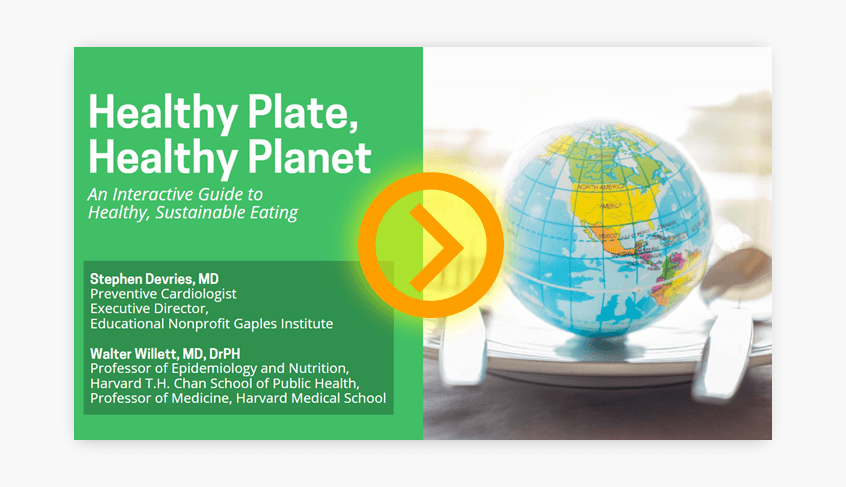A fresh new collaborative educational project from leaders of
the Gaples Institute and Harvard T.H. Chan School of Public Health, Department of Nutrition
You care about the planet, and you might already reduce, re-use, and recycle.
But what you eat could have the biggest impact of all.
What is a sustainable diet? Find out in just 10 minutes, and learn how your meals can help you and the earth to survive and thrive.

Learn which foods are planet-friendly
Discover the food choices that are gentlest on the environment—and which are most harmful.

Align your meals with planetary targets
Make small, meaningful shifts to help put the brakes on climate change.

Save the planet, one meal at a time
Put your best fork forward as you create a healthier world and a healthier body.

Give us 10 minutes, and we’ll show you simple, impactful changes you can make today to ensure the earth’s longevity—and improve your own!
Like you, we’re concerned for the future of our planet. Sustainable diets can help.
In our mission as an educational nonprofit, we want to empower you and your family to eat for optimal and sustainable health.
This 10-minute interactive learning experience will guide you toward simple dietary shifts that benefit people and the planet. It reflects the work of 37 leading health and climate scientists from 16 countries, using the best available evidence for optimal health.
Are you ready to make simple changes
toward a healthy, sustainable future?

Are you a physician or other healthcare professional?
We have a special clinician edition of this learning tool!

- Practical guidance, informed by the latest research in health and climate science
- Self-paced, interactive learning—not just a video or slide deck!
- Includes free downloadable infographic to guide your healthy, sustainable food choices
“The greatest threat to our planet
is the belief that someone else will save it.”
Robert Swan
Explorer and Environmentalist
Sustainable Diets Result in Both a Healthy Planet and a Healthy Plate
If you care about health, you already know that healthy food is good medicine. The research is clear that foods like vegetables, fruit, and healthy protein help give us longer and better lives—and a poor-quality diet often leads to disease and early death.[1] But there’s something more you need to know, and it’s just as critical to your health.
The fact is, the same foods that are harming our health are just as harmful to our planet. Our food systems—the things we do to farm, transport, and package our food—are a leading cause of environmental changes. They’re responsible for up to 30% of the world’s greenhouse-gas emissions and 70% of the fresh water we use.[2]
But here’s the good news: You have a powerful role in solving this! And in our interactive course on sustainable diets, we’ll show you how.
What is a Sustainable Diet?
A sustainable diet is one that meets your nutritional needs without jeopardizing the health of the earth and its future generations. The healthiest sustainable diets prioritize foods which are both nutrient-dense and have a low environmental impact. Eating sustainably and healthfully also means consuming only what you need. Fortunately, a sustainable diet doesn’t have to be difficult—we can each make small changes that can make our bodies and our planet healthier.
Your Powerful Role
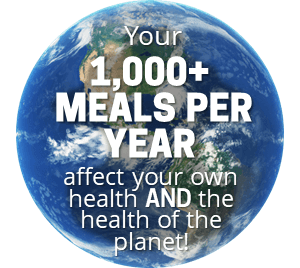 Just imagine: Every day, you make dozens of decisions about what to eat—those decisions determine what’s on your plate for 3 meals every day, and that adds up to more than a thousand meals a year! Even if you make environmentally-friendly choices for just some of those meals, you’ll make an enormous impact on your own health, and the health of the planet!
Just imagine: Every day, you make dozens of decisions about what to eat—those decisions determine what’s on your plate for 3 meals every day, and that adds up to more than a thousand meals a year! Even if you make environmentally-friendly choices for just some of those meals, you’ll make an enormous impact on your own health, and the health of the planet!
And if you live with others and influence their food choices too, your impact can be even greater! For example, if you shop or cook for 3 other people in your household, your impact jumps to almost 4,400 meals a year!
Why is Eating Sustainably Important?
But why is it so critical that we take a hard look at what we eat? Because the way our population is eating now is not sustainable. In fact, our current patterns have us on a fast track toward serious problems, for both human health and planetary health.
Diet-Related Diseases are Killing Us
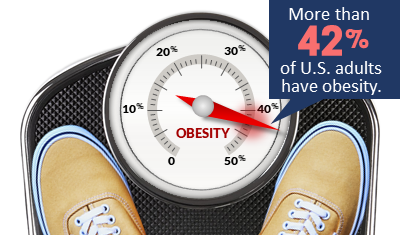 One very serious threat is obesity. Rates of obesity are surging, and so are the health problems that go with it. You might be alarmed to find out the percentage of U.S. adults with obesity is now over 42%[3]—and that number is a 40% increase from the prevalence of obesity just 20 years ago. Obesity-related cancers are also on the rise.[4]
One very serious threat is obesity. Rates of obesity are surging, and so are the health problems that go with it. You might be alarmed to find out the percentage of U.S. adults with obesity is now over 42%[3]—and that number is a 40% increase from the prevalence of obesity just 20 years ago. Obesity-related cancers are also on the rise.[4]
Diabetes is also rising quickly—globally, it’s almost double what it was 30 years ago.[2] In fact, half of U.S. adults now have to manage the conditions of either diabetes or prediabetes.[5]
And although the death rate from heart disease has been declining for several years, that decline is now leveling off[6]—and has even stopped completely in people aged 45 to 64.[7]
All these problems are deadly—and the biggest contributor to early death is poor-quality diet.[1]
So What is the Best Sustainable Diet to Fix This?
The research tells us that people who eat a sustainable diet consisting of healthy, whole foods—such as vegetables, fruits, legumes, whole grains, nuts, and fish—are much healthier than those who don’t. In fact, cultures where people historically ate this way have been known to live longer, healthier lives.
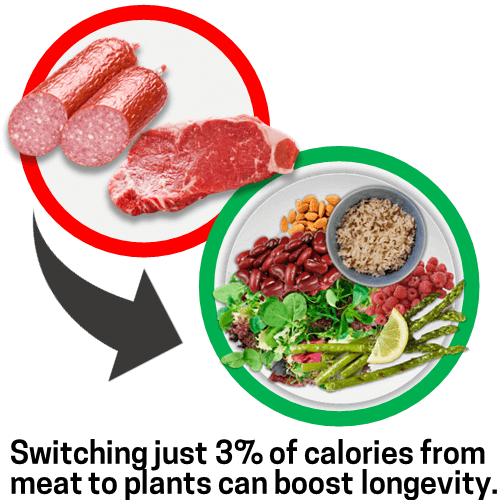 How much does shifting to a plant-forward sustainable diet help? Well, when people swap just 3% of their daily calories from meat to plant-sourced protein, the effect is remarkable: in a study where people swapped out unprocessed meat for plant protein, there was a 12% lower death rate. And swapping out processed meat resulted in a 34% lower death rate! That’s a huge benefit for just a 3% swap![8] If you’re eating around 2,000 calories a day, it would mean changing just 60 calories from meat to plants.
How much does shifting to a plant-forward sustainable diet help? Well, when people swap just 3% of their daily calories from meat to plant-sourced protein, the effect is remarkable: in a study where people swapped out unprocessed meat for plant protein, there was a 12% lower death rate. And swapping out processed meat resulted in a 34% lower death rate! That’s a huge benefit for just a 3% swap![8] If you’re eating around 2,000 calories a day, it would mean changing just 60 calories from meat to plants.
If our population shifted to eating fewer animal products and more plants, we could save about 11 million adult deaths per year. That’s almost a quarter of all premature deaths![2] And it’s easy to get plenty of high-quality protein from healthy plant-sourced foods. Most adults need about 60 grams of protein a day, which you can easily get from foods like tofu, beans, whole grains, seeds, vegetables, nuts, quinoa, and lentils.
Why the Healthy Plate You Choose Today Can Help the Future of the Earth for Years to Come
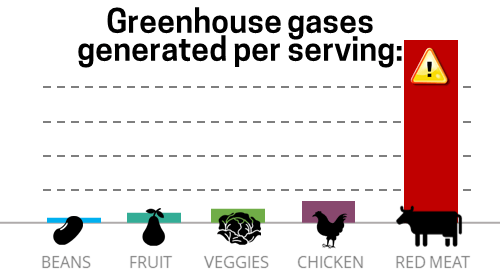 These same dietary changes that our population needs are also the changes that our planet needs in order to survive. For example, a single serving of red meat generates 180 times more greenhouse gas than a serving of beans.[9]
These same dietary changes that our population needs are also the changes that our planet needs in order to survive. For example, a single serving of red meat generates 180 times more greenhouse gas than a serving of beans.[9]
Do you know how other foods compare? The facts might surprise you! All animal-sourced foods have more than twice the harmful impact as plants—and red meat is off the charts. It’s by far the most environmentally harmful of all.[9]
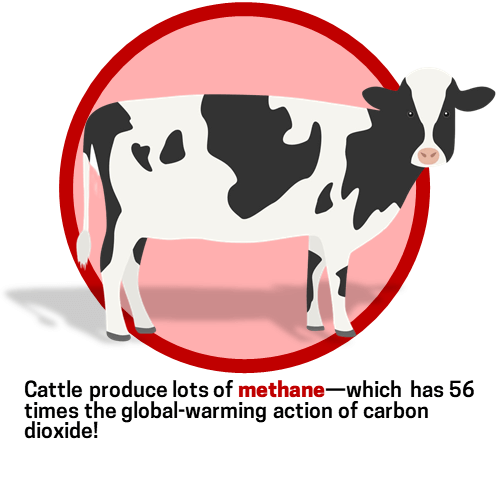 Why Cattle Are a Special Problem
Why Cattle Are a Special Problem
Cattle and some other animals, like sheep and goats, are especially problematic. Unlike humans, they can digest fiber into usable food. Their gut bacteria breaks down the fiber through fermentation. But this process produces large amounts of methane—a powerful gas with 56 times the global-warming action of carbon dioxide. The methane enters our atmosphere mainly through burps.[2]
Is Grass-Fed Beef Better for the Environment?
People often wonder if grass-fed beef is more environmentally friendly. Grass feeding often provides a better quality of life for the animals, and the meat produced is slightly healthier. But compared to conventional farming methods, grass-fed livestock offers no clear advantage when it comes to how much greenhouse gas is produced. Here’s why: Grass-fed cattle grow more slowly than feed-lot animals. Since they take longer to reach market weight, they end up producing more methane over a longer period of time.[10]
Seafood as an Alternative
What about eating seafood instead of meat? The environmental impact of seafood varies a lot based on the species, the location, and the way it’s produced. For wild-caught seafood, the biggest contributors to greenhouse gas emissions are the fuel used by fishing vessels, and the refrigeration for preserving the catch. For farmed seafood, the biggest impact comes from producing feed. Farmed aquatic animals are raised on fishmeal, fish oil, and agricultural products like grains and soy.
Bivalves—a type of shellfish with a hinged shell, such as mussels—are among the least harmful to the environment, because they don’t need feeding. Instead, they live on plankton that they filter from the water. Mussels are an especially good choice. They have a smaller environmental footprint than most fish, and they contain high levels of Omega-3—a type of fat with important health benefits.[11]
The Heat’s Being Turned Up
With all the greenhouse gases our population is producing, too much heat is being trapped in our atmosphere—and it’s making the planet precariously hot. The number of high-heat days in the U.S. is rising year over year, and temperatures will become increasingly dangerous if we don’t make significant changes now.[12]
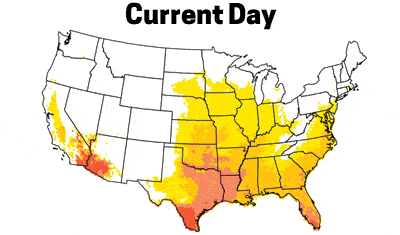 A hotter planet brings a host of health problems:[13][14]
A hotter planet brings a host of health problems:[13][14]
- Excessive heat can mean more heart attacks and deaths related to heart and lung diseases.
- As regions get warmer, allergy seasons get longer, and some infectious diseases can increase.
- Dangerous climate events like wildfires, heat waves, droughts, and floods become more frequent and extreme—and they often devastate entire communities and their economies.
- As temperatures rise, so do our sea levels—and when saltwater seeps further into our land, there’s less fresh water available for drinking and farming.
- We also lose coastal land, which causes economic disruptions and climate migrants—people who are displaced when their homes are damaged or destroyed.
How to Shift Toward a Healthy Sustainable Diet
We know that replacing animal products with healthy plant-sourced foods is a powerful swap for both personal health and the planet’s health. Next let’s learn specific guidelines that’ll help you eat a more healthful, sustainable diet. These guidelines are based on the work of the EAT-Lancet Commission—37 leading scientists from 16 countries who convened in 2019 to publish a scientific framework for healthy, sustainable eating. Their work is based on the best available evidence for optimal health.[2]
A Prescription for Sustainability
For people who are able, one excellent approach is a completely plant-sourced diet. This way of eating not only protects the planet, it’s also a great choice for human health. In a healthy plant-sourced menu, each meal features a plate that is at least half full of vegetables and fruit, and the other half can be a combination of nuts, whole, grains, and legumes—such as lentils or beans.
But some people are just beginning to cut back on animal products—or they don’t want to eliminate them completely. If that’s you, you can still include modest amounts of animal-sourced foods throughout the week.
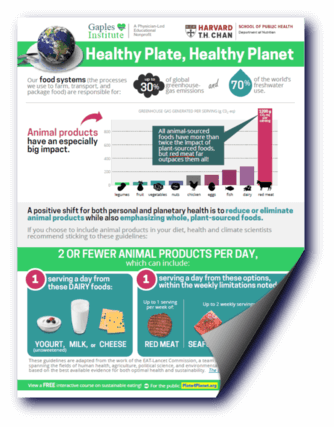
Here are the limits that he EAT-Lancet Commission identified if you decide to include animal-sourced foods in a sustainable diet.
Try to include 2 or fewer animal products a day, total. That can include:
- 1 dairy serving each day, such as unsweetened yogurt, milk, or cheese
- and 1 serving a day of other animal products—but limiting red meat to 1 serving a week, and up to 2 servings a week of seafood, poultry, and eggs.
In our 10-minute course on sustainable eating, you can explore an interactive one-week menu to see what these guidelines could look like—plus download an infographic of healthy planetary guidelines.
Even Small Changes are Valuable
If you currently eat animal products often, it might be helpful to focus on taking small positive steps—especially if a drastic change seems difficult. For example, if you currently eat the U.S. average of 5 or more weekly servings of meat,[15] it might feel more realistic to set a modest initial goal—such as 3 weekly servings—while ultimately working toward a goal of 1 or fewer servings a week.
Even if you reduce animal products by a little, the payoff is significant. For example, reducing meat intake by just 2 servings a week, saves the same amount of greenhouse gas generated by driving 5 miles![9][16] If you cut just a little further to one serving a week, it’s like reducing greenhouse-gas production by the equivalent of more than a 10-mile drive!
And the benefits are just as remarkable for our health. In one study, cutting red meat intake by more than half a serving a day lowered diabetes risk by 14%.[17]
Sustainable Eating: Your Call to Action
By taking the time to learn healthy planetary guidelines, you’re making an important first step toward a healthier body and a healthier planet. To finish, let’s learn 3 important actions you can begin taking right now.
 First, eat less meat. If you currently eat meat, a good start is to add at least one or two meatless days a week. And when you do have meat, think of it as a small-side portion rather than the main feature of your meal. Most importantly: as best you can, stick to the guidelines covered above. Our 10-minute interactive course contains an infographic that you can download or print as a reminder.
First, eat less meat. If you currently eat meat, a good start is to add at least one or two meatless days a week. And when you do have meat, think of it as a small-side portion rather than the main feature of your meal. Most importantly: as best you can, stick to the guidelines covered above. Our 10-minute interactive course contains an infographic that you can download or print as a reminder.
Second, be a trendsetter. Your circle of influence is unlike anyone else’s! And you can use it to encourage healthy-planet friendly choices.
- You can start with your household. Earlier we saw that shopping or cooking for yourself and three others means you’re influencing nearly 4,400 meals a year. Your choices have a big impact on the people you live with!
- Your choices also affect your social sphere. A simple action like bringing a meat-free dish to a potluck, or choosing a plant-forward restaurant when you go out with friends, can encourage others to eat more healthfully.
- And don’t forget your workplace. See if there are ways you can advocate for healthy plant-forward choices for the dining and vending options at your work.
Lastly, share what you’ve learned with others. Together we can save the planet, one healthy plate at a time. Tell your family and friends of all ages to visit Plate4Planet.org so they can learn how to do their part too.
Are You a Clinician? Then Your Role is Especially Powerful

Most healthcare professionals typically have a patient panel of a thousand or more patients per year—each of whom has 3 meals a day. This means a clinician can directly influence 21,000 meals a week. That adds up to more than a million meals a year! Even if you influence just 10% of your patients’ meals, you’ve made an enormous difference, not only in the health of your patients, but also in the health of the planet.
And your patients are eager for your dietary guidance. 78% of consumers who get nutrition advice from their healthcare professional say that they’ve changed their eating habits as a result!
As a health professional, you have a unique opportunity to support each of your patients in shifting toward a sustainable diet. Here’s how you can do it:
Action number 1: Guide your patients to eat sustainably. Above, we noted that a clinician with a panel of a thousand could easily influence more than a million meals a year! And most patients want your help in eating sustainably! 59% say that sustainability is important in their food choices.[18] By educating yourself on sustainable diets in our interactive course for clinicians, you are perfectly poised to help them! Here are two free resources that will help:
- You can send patients to Plate4Planet.org for a special interactive course that is designed for the public.
- You can also give them the handout provided in the clinician version of the Sustainable Diets course—it’s a 1-page infographic of the healthy planetary guidelines that anyone can follow for a sustainable diet.
Action number 2: Shift your own eating. A healthy planetary diet will benefit you just as much as your patients. It’ll maximize your resilience—an important safeguard against the persistent challenge of clinician burnout.[19] You’ll also provide better patient care—research shows that clinicians who eat healthfully are more likely to counsel patients to do the same.[20] And of course you’ll reduce your own environmental footprint, since you’ll be eating within scientific guidelines for planetary health.
Action number 3: Look for ways that your workplace could align better with healthy planetary guidelines. See if there’s room for improvement in the dining and vending options for employees and visitors, as well as the inpatient menu options. Consider ways that you could advocate for healthier, sustainable diets.
References:
The State of US Health, 1990-2016: Burden of Diseases, Injuries, and Risk Factors Among US States; JAMA 2018
Food in the Anthropocene: the EAT–Lancet Commission on healthy diets from sustainable food systems; The Lancet 2019
Prevalence of Obesity and Severe Obesity Among Adults; NCHS Data Brief, Centers for Disease Control 2020
Emerging cancer trends among young adults in the USA: analysis of a population-based cancer registry; The Lancet 2019
National Diabetes Statistics Report; Centers for Disease Control 2020
Trends in Cardiometabolic Mortality in the United States, JAMA 2019
Trends in Cancer and Heart Disease Death Rates Among Adults Aged 45–64; National Vital Statistics Reports, Centers for Disease Control 2019
Association of Animal and Plant Protein Intake With All-Cause and Cause-Specific Mortality; JAMA Intern Med 2016
Comparative analysis of environmental impacts of agricultural production systems, agricultural input efficiency, and food choice; Environmental Research Letters 2017
Life-Cycle Assessment of the Beef Cattle Production System for the Northern Great Plains, USA; Journal of Environmental Quality 2013
Killer Heat in the United States: Climate Choices and the Future of Dangerously Hot Days; Union of Concerned Scientists 2019
Climate Change Synthesis Report; Intergovernmental Panel on Climate Change 2014
The 2018 report of the Lancet Countdown on health and climate change: shaping the health of nations for centuries to come; The Lancet 2018
Trends in Processed Meat, Unprocessed Red Meat, Poultry, and Fish Consumption in the United States; J Acad Nutr Diet 2019
Greenhouse Gas Emissions from a Typical Passenger Vehicle; U.S. Environmental Protection Agency 2018
Changes in red meat consumption and subsequent risk of type 2 diabetes mellitus: three cohorts of US men and women; JAMA Intern Med 2013
Food and Health Survey; Food Insight 2018
Mediterranean-type diet is associated with higher psychological resilience in a general adult population: findings from the Moli-sani study; Eur J Clin Nutr
Do healthy doctors deliver better messages of health promotion to their patients?: Data from the SUN cohort study; Eur J Public Health 2020



